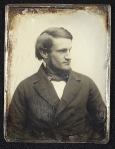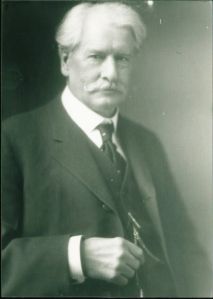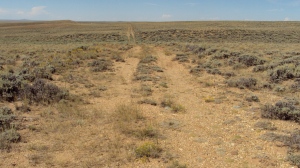When I was in school, Francis Parkman’s The Oregon Trail was on my reading list. At the age of thirteen, the formal writing and the lengthy, detailed descriptions of a time, scenery and people who did not in the least interest me, turned me towards another choice of book. So here I am, some fifty years later, with other interests, more tolerance, and certainly a more receptive mind.
Francis Parkman was born into an aristocratic Boston family, son of a well-connected and wealthy Unitarian minister. Plagued by illness most of his childhood, he was often sent into the countryside in an attempt to make him more robust. This, combined with his own enjoyment of James Fenimore Cooper’s novels, seems to have had a lasting effect on the young man whose walks in the woods always entailed carrying a rifle, just as his hero, Hawkeye, did. At Harvard, his interest in Native Americans became evident, and his desire to write histories of the United States (as well as a love of horticulture) took root. Taking time off from college to do a Grand Tour of Europe in order to recover from one bout of his neurological illness, he visited George Catlin’s Indian Gallery in London. This may have been the final push to form plans to travel west. In May, 1846, he finally set out for Independence, MO, with his equally well-heeled cousin, Quincy Adams Shaw. The duo went on to Fort Laramie where, under the sponsorship of the American Fur Company, they were outfitted and prepared for their journey to live with the Oglalla Sioux. Parkman even dressed for the part of a westerner, kitting himself out with buckskins sewn by the Oglalla women at the fort. Years later, he still possessed the outfit when Frederic Remington prepared the illustrations for the deluxe 1892 edition of Oregon Trail.
As anyone who has read The Oregon Trail will know, Parkman pushed himself through many bouts of illness, dosing himself with opium to plod on. In the end, he lived with the Oglalla for three weeks, taking copious notes that eventually formed the book. Parkman would return to Boston where he wrote numerous histories of the United States as well as becoming a professor of horticulture at Harvard, and a founder member of the Archaeological Institute of America.
The Oregon Trail was to have a great influence on the minds and hearts of
Americans. Consider that it still appeared as recommended reading for my school in 1964, and that editions are readily available today. And how many writers of western material or television scriptwriters have taken Parkman’s word and descriptions to heart?
So what is so captivating about The Oregon Trail that it has lasted this long? Parkman was very much a product of his class and times. For someone who was so intent on living with the Native Americans, he is singularly unsympathetic to their plight or their lives, repeatedly referring to them as “mongrels.” Yet while the modern reader may be rightfully appalled at these and other appellations, there is a certain fascination in how prescient Parkman’s writing is: on pg. 90 he describes a wagon train rolling past a native village: “a long train of emigrants with their heavy wagons was crossing the creek, and dragging on in slow procession by the encampment of people whom they and their descendants, in the space of a century, are to sweep from the face of the earth,” and later “…the buffalo will dwindle away, and the large wandering communities who depend on them for support must be broken and scattered. The Indians will soon be abased by whiskey and overawed by military posts…” (pg. 190) Parkman saw this as the natural march of progress much as missionaries see bringing Christianity to indigenous inhabitants a step toward civilization.
Some twenty years after Parkman’s journey, Julius Birge left his Wisconsin home to take virtually the same trip. He, too, kept notes, and forty-five years later, in 1912, these would be the basis for The Awakening of the Desert. Also descended from an old New England family, Birge, while not as formally educated as Parkman, was still incredibly well-read and had also suffered illness. One of the reasons he took the trip, which was to ostensibly deliver goods to a Mormon settlement, was to recover from a bout of typhoid. But Birge had grown up in rural Wisconsin amid Pottawattamies and Winnebagos; indeed, he was reputedly the first child ever born to non-native parents in Whitewater, WI. Because of this, Birge’s interests are totally different from Parkman’s, and, perhaps, also because of this, his judgments are gentler. However, both men dealt with Native Americans and both encountered Mormons; both men spent time at the forts along the route and both lighted upon almost identical scenery. They each had treacherous river crossings and knew hardships and thieves. In 1872, in the introduction to the fourth edition of The Oregon Trail, Parkman reassessed his view of that march of progress. He wrote, “…we did not dream how Commerce and Gold would breed nations along the Pacific, the disenchanting screech of the locomotive break the spell of weird, mysterious mountains…had we foreseen it, perhaps some perverse regrets might have tempered the ardor of our rejoicing.” Birge also had the benefit of hindsight; in 1912, some forty-five years after his journey, he knew that such an advancement, more than anything, also marked the end of “…the country as God has made it…” and that western migration was “…depraving and demoralizing even the savages.” (pg.56) His view was that, “the cities and states of America have struggled to increase their population by immigration, apparently on the theory that the rate of that increase was to be the measure of growth in the happiness and prosperity of its people. When our national heritage shall have been partitioned among the nations of the earth, and the wild, wooded hillsides shall have been denuded by axe and fire, giving place for farms and cities, then those whose fortune it has been in childhood to roam through the primitive forests or over the yet free and trackless plains, would hardly exchange the memories of those years for a cycle on the streets…” (pg. 56)
I can only wonder why he saw the desert—that great American ‘desert’, the plains—as awakened. It might have been more apposite to say that it had begun its death throes. But how apt his words are today.
The editions I used for this post are:
Birge, Julius C. and Birge, Barbara B., The Awakening of the Desert: An Adventure-Filled Memoir of the Old West, a CreateSpace 2014 reprint of 1912 edition, Gorham Press, Boston This book is also available at Audible.com For further information, go to http://theawakeningofthedesert.com
Parkman, Francis, The Oregon Trail, Dover Publication, Inc., Mineola, NY, 2002, reprint of 1883 edition, Little, Brown, and Company, Boston.
Parkman, Bierstadt and b & w Oregon Trail photos Public Domain; photos of Julius Birge and South Pass, courtesy of Barbara Birge





















Interesting comparison.
I was always a little disappointed by Parkman, though – he definitely seemed to be the worst sort of snob, and so very focused on his interest in the Indians that he had no time for the emigrants. I read some years ago (can’t remember where) that one of the wagon train parties that he crossed paths with around Laramie was the Donner-Reed Party … but they weren’t his kind. So dismissed from attention.
LikeLike
Celia, as I say, Parkman was very much a product of his elitist background so while the Indians were a people he wished to study, the emigrants were not of his class. He did, indeed, meet members of the Donner party outside Fort Laramie at a smaller fort. There is a two pg. description, too long to quote here, but, here is some of it (pgs. 126-127) “A company of California emigrants…had made the discovery at this late day that they had encumbered themselves with too many supplies for their journey. A part, therefore, they had thrown away,or sold at great loss to traders; but had determined to get rid of their very copious stock of Missouri whiskey, by drinking it on the spot…” He then goes on to say he met the leader of the party who told him, “His men…had mutinied and deposed him; but still he exercised over them the influence of a superior mind…As the Colonel spoke, I looked round on the wild assemblage, and could not help thinking that he was but ill fitted to conduct such men across the deserts to California….Fearful was the fate that, months after, overtook some of the members of that party…They were interrupted by the deep snows among the mountains, and, maddened by cold and hunger, fed upon each other’s flesh!”
LikeLike
Thank you, Andrea, this is such an informative and interesting post.
PS I’ve been reading John Demos’ THE UNREDEEMED CAPTIVE, about early colonial New England– when the Connecticut River running through the middle of Massachusetts marked the (then) Wild West. It seems to me that many of the attitudes of New Englanders towards indigenous peoples were fired in that particular cauldron. The burning of Deerfield would have been a memory as close as– actually closer than– the Civil War is for those of us now in our 50s and older. (I remember my great grandmother, who grew up in the house of a Civil War veteran.) But whatever the memories may have been, for a writer to see with the heart is a rare feat.
LikeLike
I read the Demos book several years ago so it’s not too fresh in my mind as to particulars, but I think you’re right. In fact, I believe it was Birge who later said somewhere that it was his Puritan background that colored many of his views–and he was brought up in WI. Think then of how Parkman, imbued with that old Bostonian birthright, must have viewed Native Americans, and that despite his willingness to live with them and fascination with them.
LikeLike
Very interesting and how perseptive. Trouble is, things are constently changing. Some for the better and some not. I’m glad conservationists had the foresite to save some of the landscapes from being plowed over.
LikeLike
Ilona, I hate to disillusion you but I don’t think it was conservationists who originally saved the sites, although now I’m told there is indeed an Oregon-California Trails Association who are responsible for the various markers one can see at different points along the trails.
LikeLike
Nice overview of the two men and their worlds, Andi. I’ve heard that the Western movement did a number on flora and fauna…only now have the numbers/species of animals come back to populate areas where forefathers hunted everything down. One bright spot in a very dreary past.
LikeLike
They are coming back, but mostly in the national parks where they’re not hunted. Consider that once 50 Million buffalo roamed the plains. Now, that’s not gonna happen–but there is a nice herd up in Yellowstone and a few in other parks. It’s the old man vs beast thing. Wolves are coming back but the ranchers don’t want them, and so on. Thanks for your comment, Rolynn; as always, greatly appreciated.
LikeLike
Wonderfully informative blog post.
LikeLike
Thanks Angelina. I appreciate you stopping by.
LikeLike
I read the Oregon Trail years ago and remember very little about it, so glad you reviewed it for us. Just as today, we view others from our own experiences, shaped by many forces including our social environment. My dad appears to have been something of a free-thinker, his mother and his sisters,except for one, very social conscious. From Cornish stock with dark hair and eyes, he’d tell people, much to his siblings horror that they possessed Indian blood. This in Oklahoma in the early 1900s!
About the Donner/Reed party. I researched them some years ago for my book, Trapped! George Donner did not possess leadership qualities, but was well-liked and viewed as the common man. Reed likely had the better leadership skills, but, as a descendant of nobility, he was too
“aristocratic” in the common man’s view to be trusted. I know, he took the “Cut-Off” too, but they might not have, had he been in charge, and even so, had they not banned him from the wagon train, they might have made it over the Sierras before the heaviest snowfall. It seems the biggest problem of all was the lack of co-operation among the whole group, and as a leader George Donner could not get them in sync and pulling together much to the detriment of all.)
LikeLike
Of course, it’s very difficult to know whether Parkman’s view and perception of the Donner party, as I quoted several comments below, is truthful or biased, or even correctly remembered on his part. Since he heard about the loss of life etc. in that camp, it’s always possible that he went back into notes and confused their drunkenness with another party of emigrants–and he does seem to be particularly prejudiced against those travelers on the whole. So now layer his biased views with our own views biased from a modern stand point and where does one get the truth?
LikeLike
Just as Shakespeare wrote that the “good is oft interred with their bones”, so I think is the truth. Besides one man’s truth, as seen through his eyes, is not necessarily seen that way through another’s. So as you say, “Where does one get the truth.” Also, what is the truth? Ahh…. Constant fodder for us writers. 🙂
LikeLike
Fodder for writers and historians alike!
LikeLike
This was an interesting and well-written post, Andrea. Thank you for sharing.
LikeLike
My pleasure! A friend gave me the Birge book and I had already got the Parkman on my TBR so things just gelled…
LikeLike